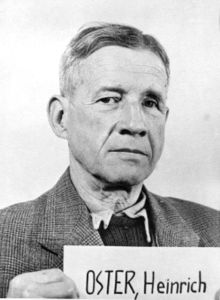Heinrich Oster

Heinrich Oster (born May 9, 1878 in Strasbourg , † October 29, 1954 in Essen ) was a German chemist , board member at BASF and IG Farben , and convicted war criminal .
Life
Oster attended grammar school in Speyer and did his military service in 1898 as a so-called one-year volunteer. He then began studying chemistry in Berlin and graduated in 1903 with a diploma . After graduating in 1903 , Oster received his doctorate in 1905 with a dissertation on indophenia and then worked for Agfa . Oster took part in the First World War as a soldier from 1914 . Soon after the war began, Oster lost his left eye due to a war injury. He was then assigned to the staff of the commander of the German troops in Alsace , and from 1917 worked as a war office commissioner for the arms and ammunition procurement office at BASF .
In 1918 he became a director at BASF and was a member of the board of directors there in 1921. In 1926 he was appointed deputy member of the board of IG Farben. From 1931 until the end of the war in 1945, Oster was a full board member of IG Farben . There he belonged to the “Working Committee” and in 1937 to the Commercial Committee and the “Fertilizers and Explosives” sub-commission and managed the business of the Nitrogen Syndicate GmbH. Oster, a supporting member of the SS from 1935 to 1939, joined the NSDAP in 1940 and was awarded the First Class War Merit Cross (KVK) a year earlier .
In April 1940 he arrived with the Wehrmacht in occupied Norway to secure the nitrogen products of Norsk Hydro for German war production.
After the end of the war, Oster was arrested by the US Army in 1946 and charged with 22 other accused in the IG Farben trial during the Nuremberg trials . On July 30, 1948, he was sentenced to two years imprisonment for "looting and robbery". In the grounds of the judgment, the following was stated about the conviction of Oster:
"It emerged that Oster was a member of the Norsk-Hydro supervisory board after the initiation of the Nordisk-Lettmetall project, and that he was informed of the general nature and purpose of the program on the basis of the board meetings and the reports sent to him, which provided for the use of the Norsk Hydro factories for the expansion of light metal production in Norway to promote air force production [...] The evidence has shown [...] Osters knowledge of the fact that the project was against the will of the Norsk- Hydro was carried out [...] Knowing these circumstances, he agreed to the participation of the IG in the project. "
After his release from the Landsberg War Crimes Prison , Oster was again a member of the Supervisory Board of Gelsenberg AG in 1949 . Oster died in Essen at the end of October 1954.
literature
- Jens Ulrich Heine: Verstand & Schicksal: The men of IG Farbenindustrie AG (1925-1945) in 161 short biographies. Weinheim, Verlag Chemie, 1990. ISBN 3527281444
Web links
Individual evidence
- ^ Robert Bohn: Reichskommissariat Norway: "National Socialist Reorganization" and War Economy, Oldenbourg Wissenschaftsverlag, 2000, ISBN 9783486564884 , p. 273
- ↑ From the pronouncement of the verdict in the IG Farben trial. Quoted in: Wollheim Memorial from The verdict in the IG Farben trial. The full text. , Offenbach am Main, Bollwerk 1948, p. 104.
| personal data | |
|---|---|
| SURNAME | Oster, Heinrich |
| BRIEF DESCRIPTION | German chemist and defendant in the IG Farben trial |
| DATE OF BIRTH | May 9, 1878 |
| PLACE OF BIRTH | Strasbourg |
| DATE OF DEATH | October 29, 1954 |
| Place of death | eat |